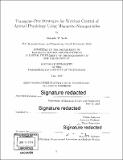| dc.contributor.advisor | Polina Anikeeva. | en_US |
| dc.contributor.author | Senko, Alexander W.(Alexander William) | en_US |
| dc.contributor.other | Massachusetts Institute of Technology. Department of Materials Science and Engineering. | en_US |
| dc.date.accessioned | 2019-10-11T22:10:55Z | |
| dc.date.available | 2019-10-11T22:10:55Z | |
| dc.date.copyright | 2019 | en_US |
| dc.date.issued | 2019 | en_US |
| dc.identifier.uri | https://hdl.handle.net/1721.1/122538 | |
| dc.description | Thesis: Ph. D., Massachusetts Institute of Technology, Department of Materials Science and Engineering, 2019 | en_US |
| dc.description | Cataloged from PDF version of thesis. | en_US |
| dc.description | Includes bibliographical references (pages 130-141). | en_US |
| dc.description.abstract | Bioelectronic medicines are emerging therapies designed to control human physiology using electrically actuated stimuli instead of drugs. The most famous example is deep brain stimulation (DBS) for Parkinson's disease, in which electrodes are used to control brain activity and prevent tremors. An idealized version of this therapy would use soft materials and be wireless in order to be minimally invasive and cause minimal damage to brain tissue. Magnetic fields are an appealing candidate for wireless therapies because at many frequencies and amplitudes, the human body is similar enough in its magnetic response to vacuum that magnetic fields can penetrate arbitrarily deep. When combined with magnetic nanoparticles of biocompatible iron oxide, which can dissipate heat or produce forces when subjected to applied magnetic fields, magnetic fields can be applied from outside the body and evoke a physiological response within. This thesis describes the synthesis of large disc-shaped magnetic particles which undergo mechanical motion under lower frequency alternating magnetic fields. This mechanical motion enables a new paradigm of activating mechanosensitive ion channels, with increased scalability of the magnetic field apparatuses compared to the high-frequency fields needed to produce heat from magnetic nanoparticles. Wireless magnetic nanoparticle-mediated stimulation has often relied on transgenes, but by choosing tissues that endogenously express the proteins required to detect the physical stimuli (like heat or force) produced by the nanoparticles, it is possible to avoid the need for transgenes. Not relying on transgenes significantly lowers the barrier to clinical translation of this therapy platform. | en_US |
| dc.description.statementofresponsibility | by Alexander W. Senko. | en_US |
| dc.format.extent | 144 pages | en_US |
| dc.language.iso | eng | en_US |
| dc.publisher | Massachusetts Institute of Technology | en_US |
| dc.rights | MIT theses are protected by copyright. They may be viewed, downloaded, or printed from this source but further reproduction or distribution in any format is prohibited without written permission. | en_US |
| dc.rights.uri | http://dspace.mit.edu/handle/1721.1/7582 | en_US |
| dc.subject | Materials Science and Engineering. | en_US |
| dc.title | Transgene-free strategies for wireless control of animal physiology using magnetite nanoparticles | en_US |
| dc.type | Thesis | en_US |
| dc.description.degree | Ph. D. | en_US |
| dc.contributor.department | Massachusetts Institute of Technology. Department of Materials Science and Engineering | en_US |
| dc.identifier.oclc | 1121596380 | en_US |
| dc.description.collection | Ph.D. Massachusetts Institute of Technology, Department of Materials Science and Engineering | en_US |
| dspace.imported | 2019-10-11T22:10:54Z | en_US |
| mit.thesis.degree | Doctoral | en_US |
| mit.thesis.department | MatSci | en_US |
